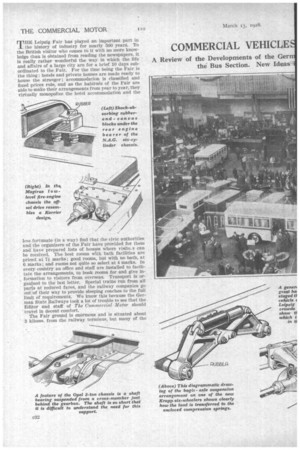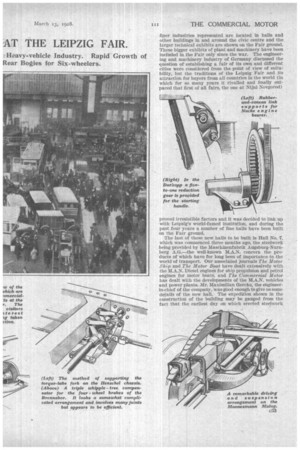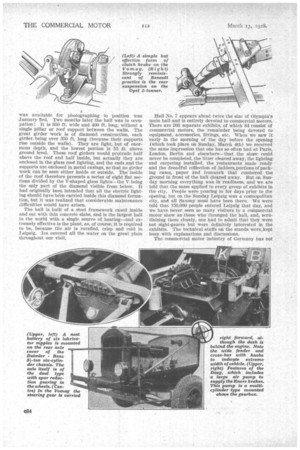COMMERCIAL VEHICLE AT THE LEIPZIG FAIR.
Page 62

Page 63

Page 64

Page 65

If you've noticed an error in this article please click here to report it so we can fix it.
A Review of the Developments of the Ger the Bus Section. New Ideas Heavy-yehicle Industry. Rapid Growth of Rear Bogies for Six-wheelers.
THE Leipzig Fair has played an important part in the history of industry for nearly 500 years. To the British visitor who comes to it with no more knowledge than is obtained from reading the newspapers, it is really rather wonderful the way in which the life and affairs of a large city are for a brief 10 days subordinated to the Fair. For the time being the Fair is the thing: hotels and private houses are made ready to house the stranger ; accommodation is classified and fixed prices rule, and as the habitues of the Fair are able to make their arrangements from year to year, they virtually monopolize the hotel accommodation and the less fortunate (in a way) find that the civic authorities and the organizers of the Fair have provided for them and have prepared lists of houses where visito.s can be received. The best rooms with bath facilities are priced at 7 marks ; good rooms, but with no bath, at 6 marks; and rooms not quite so select at 4 marks. In every country an office and staff are installed to facilitate the arrangements, to book rooms for and give in_ formation to visitors from overseas. Transport is organized to the last letter. Special trains run from all parts at reduced fares, and the railway companies go out -of their way to provide sleeping coaches to the full limit of requirements. We know this because the German State Railways took a lot of trouble to see that the Editor and staff of The Commercial Motor should ' travel in decent comfort.
The Fair ground is enormous and is situated about 3 kiloms. from the railway terminus, but many of the finer industries represented are located in halls and other buildings in and around the civic centre and the larger technical exhibits are shown on the Fair ground. These bigger exhibits of plant and machinery have been included in the Fair only since the war. The engineering and machinery industry of Germany discussed the question of establishing a fair of its own and different cities were considered from the point of view of suitability, but the traditions of the Leipzig Fair and its attraction for buyers from all countries in the world an which for so many years it rivalled and finally outpaced that first of all fairs, the one at Nijni Novgorod) proved irresistible factors and it was decided to link up with Leipzig's world-famed institution, and during the past four years a number of fine halls have been built on the Fair ground.
The last of these new halls to be built is Hall No. 7, which was commenced three months ago, the steelwork being provided by thel4laschinenfabrik Augsburg-Nurnberg £G.—the well-known M.A.N. concern the products of which have for long been of importance to the world of transport. Our associated journals The Motor Ship and The Motor Boat have dealt extensively with the M.A.N. Diesel engines for ship propulsion and petrol engines for motor boats, and The Commercial Motor has dealt with the developments of the M.A.N. vehicles and power plants. Mr. Maximilian Gercke, the engineerin-chief of the company, was gOod enough to give us some details of the new hall. The expedition shown in the construction of the building may be gauged from the fact that the earliest day on which erected steelwork
was available for photographing in position was January 3rd. Two months later the hall was in occupation! it is 350 ft. wide and 400 ft. long, without a single pillar or roof support between the walls. The great girder work is of diamond construction, each girder. being over 350 ft. long (because their supports rise outside the walls). They are light,, but of enormous depth, and the lowest portion is 55 ft. above ground level. These roof girders would protrude half above the roof and half inside, hut actually they are enclosed in the glass roof lighting, and the ends and the supports are enclosed in metal casings, so that no girder work can be seen either inside or outside. The inside of the roof therefore presents a series of eight flat sections divided by the V-shaped glass lights—the V being the only part of the diamond visible from below. It had originally been intended that all the electric lighting should have been carried inside this diamond formation, but it was realized that considerable maintenance difficulties would have arisen.
The hall is built of a steel framework cased inside and out with thin concrete slabs, and is the largest hall in the world with a single source of heating—and extremely effective is the plant, as, of course, it is required to be, because the air is rarefied, crisp and cold in Leipzig. Ice covered all the water on the great plain throughout our visit. Hall No. 7 appears about twice the size of Olympia's main hall and is entirely devoted to commercial motors. There are 203 separate exhibits, of which 84 consist of commercial motors, the remainder being devoted to equipment, accessories, fittings, etc. When we saw it early in the morning of the day before the opening (which took place on Sunday, March 4th) we received the same impression that one has so often had at Paris, London, Berlin and elsewhere—that the show could never be completed, the litter cleared away, the lighting and carpeting installed, the restaurants made ready and the dreadful collection of ladders,portions of packing cases, paper and ironwork that cumbered the ground in front of the hall cleared away. But on Sunday morning everything was in readiness, and we are told that the same applied to every group of exhibits in the city. People were pouring in for days prior to the Opening, but on the Sunday Leipzig was a cosmopolitan city, and all Saxony must have been there. We were told that 150,000 people entered Leipzig that day, and we have never seen so many visitors to a commercial motor show as those who thronged the hall, and, scrutinizing them closely, one had to admit that they were not sight-gazers but were definitely interested in the _ exhibits. The technical staffs on thestands were kept busy with explanations and discussions.
The commercial motor intinstry of Germany has not set out to produce new models for Leipzig because the Berlin Show jn November will be a more suitable ocQa' sion for the display of innovations. But there is muth to interest and instruct among the exhibits now on view
Early on Monday morning King Aman'all, of Afghanistan, paid an official visit to the Fair, and was first conducted over the big machinery hall and then across to Ha11. No. 7, where the commercial motors were staged. From the lengthy conversations in each place, it was evident that His Majesty has a deep interest in mechanism, and this being probably known to the or
ganizers orthe Fair therdecided that the official pre-" . sent from the town of Leipzig, or, rather, from the Fair '(much the same•thing, let it. be known t) should be the magnificent 9-ton Bussing six-wheeled lorry on exhibition. The Afghan royal coat-of-arms was painted on the sides of the body in honour of the event. The town bought the lorry from the Bussing Co. for the .purpose, and after the presentation it bore this illuminating announcement painted beside the coat-of-arms: " Geschenk des Leipziger Messantes an 5.31. Konig Aman Ullah von Afghanistan."




























































































































